#Harvard Art Studio
Explore tagged Tumblr posts
Text
Whimsical Watercolor Wonders
Every time I have a regularly scheduled class, I look forward to the first few minutes of everyone arriving so I can see all the beautiful paintings they’ve worked on for “homework.” And yesterday was no surprise that the Whimsical Watercolor students blew my socks off with their doodles and paintings! Take a look:
Aren’t they just lovely? It never ceases to amaze me how the same project can be translated so differently among students. I love their use of color and their interpretations are stunning! Way to go, ladies!
#watercolors#adult watercolor classes#beginner watercolor classes#in-studio watercolor art class#Introduction to Watercolors#adult art class#Adult Art Lessons#art class near me#Art Studio Harvard MA#handmade in Harvard#Harvard Art Studio#Harvard MA art studio#Art Studio Littleton MA#Littleton Art Studio#Littleton MA art studio#Glimmerbug#Glimmerbug Handmade Art#glimmerbugartstudio#glimmerbughandmadeart
0 notes
Text

Bolton and Harvard Open Studios https://bit.ly/3Dfx3cq
https://bit.ly/3Dfx3cq
0 notes
Text
Eggleston’s Slideshows
I’ve seen a lot of William Eggleston prints over the last few decades and own a handful of the books published during that time. Going to the “Last Dyes” exhibit at Zwirner LA, I wasn’t expecting novelty, but there it was: a gallery with a slide projector.

a man taking a photo of the projected Eggleston slide (untitled 1970). Two Breuer Wassily chairs were set up to enjoy the slideshow.
The gallery with the slideshow was relegated to a room under the stairwell. Unfortunately, I didn’t take a photo of the wall text, but it describes a period in the early 1970s when Eggleston was shooting a lot of slide film, but had not yet figured out an acceptable way to print from it. Stephen Shore visited Eggleston in Memphis and experiencing this body of work as a slideshow, says in it he recognized Eggleston’s genius.
Wondering if other Eggleston exhibits have featured slideshows I found Anna Kivlan's 2007 MIT thesis, which featured a quote from an interview she conducted with Eggleston’s wife Rosa, specifically about seeing the work as a slideshow: "It was so saturated and so intense," she said. "It was astounding to see color like that.”

Stephen Shore Eggleston in Memphis, Tennessee, December 1973 (perhaps during the visit described above)
Michael Almereyda's "Winogrand Color" describes how Winogrand had a slideshow in the highly influential 1967 "New Documents" exhibit at MOMA that also featured Diane Arbus and Lee Friedlander (who used color for portraits of musicians). But the projector malfunctioned and burned eleven slides. The slideshow was removed and after this meltdown Winogrand shot very little color.
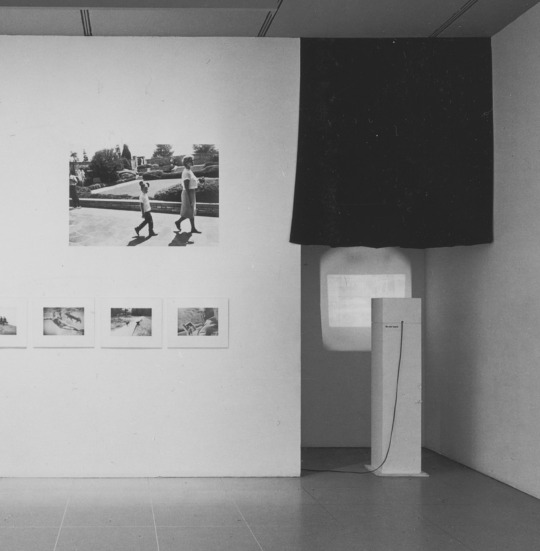
installation view of MOMA 1967 exhibit "New Documents" showing Winogrand's slideshow: is it possible housing the projector in the custom box caused the meltdown? In 1974 MOMA had an exhibition of 40 color Helen Levitt photographs, presented as a slideshow (“Projects: Helen Levitt in Color”). The documentation for this exhibit is sparse, the MOMA site offers a single short press release. Levitt had been shooting color slides as early as 1959, but her studio was robbed and she was forced to shoot new work ahead of this exhibit. That same year Eggleston, then teaching at Harvard, discovered the dye transfer process - which gave him the ability to take his own Kodachrome slides and make deeply saturated color prints. He made a portfolio of these prints ("14 Pictures").

Untitled, 1972
Despite Levitt’s earlier exhibit and the fact that her color work is great, Eggleston’s 1976 exhibit at MOMA was considered groundbreaking and established him as co-king of “new color” (along with Stephen Shore, who was the first living photographer to have a one-person show at the Met, in 1971). Hilton Kramer of the Times fell for the bait and solidly panned Eggleston’s show, telling on himself by calling it "perfectly boring."

Helen Levitt, early 1970s - the color of cars is prominent in both Eggleston and Levitt's work from this era
A mix of factors beyond blatant sexism explains passing over Levitt in the crowning of the new color photographers. She had established herself with black and white, while Eggleston appeared on the scene as color first. Winogrand's color work was similar to Levitt's in this regard. Levitt was 63, Eggleston 37. The regional content Eggleston captured (along with William Christenberry) was more exotic to the art establishment than NYC streets. Perhaps most importantly, the new color photographers had a detached mode of observation, a pop sensibility. Kramer even uses the phrase "snapshot chic" in his negative review.

from soup cans to Wonder Bread - Eggleston, Untitled, 1970
Perhaps the slide projector made it easy to overlook Levitt's exhibit. The Kodak Carousel was connected to the experience of family vacation photos. It’s unlikely that Kramer was aware that Eggleston had been doing slideshows for years, but "snapshot chic" fits. If the art world's embrace of color photography was a decade-late concession to pop (a teenage Shore at Warhol’s Factory comes to mind), the carefully printed dye transfer print was more conservative than the slideshow.
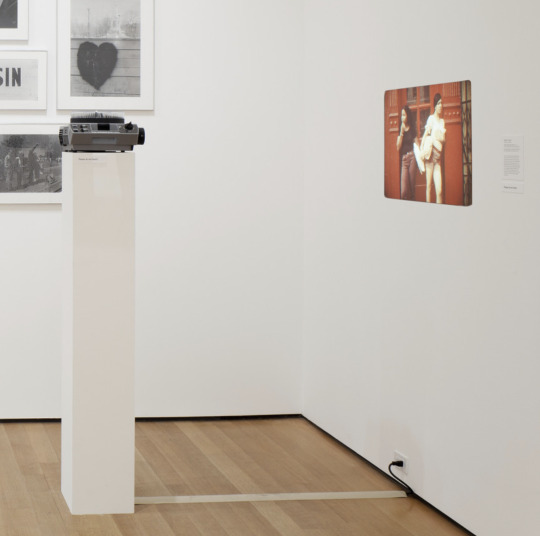
installation view of Helen Levitt slideshow from a 2012-2013 MOMA exhibit recreating the 1974 slideshow
Understanding the "new color" of the 1970's involves a specific set of films. Kodachrome produces a positive (you can hold it up to the light and see the image). When you hold color negative (C-41) film up, it’s inverted. Sebastian Siadecki’s blog post on the myth-making around Eggleston carefully dissects often repeated half-truths by lazy art writers about both Kodachrome and dye transfer prints. He points out that, while a lot of well-known Eggleston is Kodachrome, he was using Ektachrome positive and later mostly C-41 negative film (as Eggleston felt it had improved).
Stephen Shore describes his Met exhibit prints (presumably shot on C-41 film) as created like most snapshots of the time: "a machine in the big Kodak processing plant in Fairlawn, New Jersey, and stuck to the wall with double-sided tape." Siadecki points out Shore's early color work was shot with a Rollei 35 (a new version of this camera has been released) with Kodak Vericolor film.
Kodachrome was a superior film (in sharpness and color rendering) to the C-41 films and Ektachrome, but its limitations were less available locations to develop it, slower speed and the difficulty in printing. Kodachrome’s pleasing chiaroscuro is often a result of the slow speed, iso 25 or 64 (iso 200 arrived in 1986). Shooting an indoor scene without a flash was pushing the boundary of what could be hand-held without motion blur. While sitting in a Howard Johnson's Eggleston uses his Leica glass, shot wide open, the shadows go deep and he plays with light glinting through glass, like Dutch artists did 300 years earlier.


Untitled, 1972 / Pieter Claesz, 1643
Dye transfer printing materials have been discontinued and the printers are winding down their work in the medium. Zwirner produced an in-depth 18 minute video along with the exhibit to show how the prints were made. It shows how involved and time-consuming the process is.
youtube
This last set of dye transfer prints are fairly uniform at about 20 x 24 inches, or the reverse. This process can be fetishized like audiophiles with vinyl. After spending an hour with them, I circled back on a handful of the prints that were staggeringly perfect in tone and detail. Others could be done at this size in ink jet by a talented printer, with most viewers not being able to tell the difference. A few felt too enlarged, making the older print size (with max width at roughly 20 inches) seem preferable.

untitled, 1972 - in person this print was the most full-tilt, perhaps over the top, example of dye transfer
The content of the slide show and the prints heavily overlapped, but there were a handful of frames in the slide show that were not hung as prints (including the famous tricycle).
Using a slide projector is harsh on slides (a very hot light bulb can fade colors and fuse dust), so the exhibit slides were reproductions, with the original tricycle safe in a temperature-controlled location.
Some of the exhibit slides did have faded colors and dust (most obviously the abandoned airplane). I didn’t time the interval set on the Carousel, but recall it was at least 30 seconds. The gallery was not dark enough to fully experience the contrast and color saturation that Rosa Eggleston describes seeing 50 years ago.
There was no indication that the Carousel with a set of slides was for sale, but an edition of slides would represent this significant early period in Eggleston’s history. Sitting there for 15 minutes or so, I considered downloading the jpegs from the exhibit site and making an Eggleston slideshow with a modern LED projector to enjoy in my own home. I would just need the sound of a whirring fan, the clunk of the wheel advancing and cigarette smoke to complete the experience.
20 notes
·
View notes
Text
Want to learn something new
Want to learn something new in 2022??
Absolute beginner adult ballet series (fabulous beginning teacher)
40 piano lessons for beginners (some of the best explanations for piano I’ve ever seen)
Excellent basic crochet video series
Basic knitting (probably the best how to knit video out there)
Pre-Free Figure Skate Levels A-D guides and practice activities (each video builds up with exercises to the actual moves!)
How to draw character faces video (very funny, surprisingly instructive?)
Another drawing character faces video
Literally my favorite art pose hack
Tutorial of how to make a whole ass Stardew Valley esque farming game in Gamemaker Studios 2??
Introduction to flying small aircrafts
French/Dutch/Fishtail braiding
Playing the guitar for beginners (well paced and excellent instructor)
Playing the violin for beginners (really good practical tips mixed in)
Color theory in digital art (not of the children’s hospital variety)
Retake classes you hated but now there’s zero stakes:
Calculus 1 (full semester class)
Learn basic statistics (free textbook)
Introduction to college physics (free textbook)
Introduction to accounting (free textbook)
Learn a language:
Ancient Greek
Latin
Spanish
German
Japanese (grammar guide) (for dummies)
French
Russian (pretty good cyrillic guide!)

Jan 2, 2023
Want to learn something new in 2023??
Cooking with flavor bootcamp (used what I learned in this a LOT this year)
Beekeeping 101
Learn Interior Design from the British Academy of Interior Design (free to audit course - just choose the free option when you register)
Video on learning to read music that actually helped me??
How to use and sew with a sewing machine
How to ride a bike (listen. some of us never learned, and that's okay.)
How to cornrow-braid hair (I have it on good authority that this video is a godsend for doing your baby niece's black hair)
Making mead at home (I actually did this last summer and it was SO good)
How to garden
Basics of snowboarding (proceed with caution)
How to draw for people who (think they) suck at art (I know this website looks like a 2003 monstrosity, but the tutorials are excellent)
Pixel art for beginners so you can make the next great indie game
Go (back) to school
Introduction to Astronomy (high school course - free textbook w/ practice problems)
Principals of Economics (high school course - free textbook w/ practice problems)
Introduction to philosophy (free college course)
Computer science basics (full-semester Harvard course free online)
Learn a language
Japanese for Dummies (link fix from 2022)
Ukrainian
Portuguese (Brazil)
American Sign Language (as somebody who works with Deaf people professionally, I also strongly advise you to read up on Deaf/HoH culture and history!)
Chinese (Mandarin, Simplified)
Quenya (LOTR fantasy elf language)

Dec 26, 2023
Want to learn something new in 2024??
Beginner-oriented video on how to sail
This guy has so many videos on baking different types of bread. SO very many.
Coding in Python - one of the most flexible and adaptable high-level programming languages out there - explained through projects making video games
Learn to swim! (for adult learners. I don’t care if you live in Kansas or Mali or wherever. LEARN TO SWIM.)
Learn how quantum mechanics works. Then read some more about it
[Learn about quantum mechanics again, but in a more advanced engineering/mathematics class. Then read more about the math and physics of it]
Poetry Handbook, by Mary Oliver
Something I learned this year: how to sew a quilt (Here’s a very easy beginning pattern that looks amazing and can be done with pre-cut fabric!)
How to hit the ball in softball
Tutorial video on what is under the hood of most (gas) cars + weird engine sounds and what they mean
Full beginner mechanics technical training, if you want to go more in depth
Playlist on how car engine physics work if you want to go ultra in depth
Lecture series on architecture design through study of buildings
How (American income) taxes & tax law work (choose “audit course” at checkout for free class)
Pickleball for beginners (so you can finally join your neighbor/friend/distant cousin who is always insisting you join their team)
+ Para-Pickleball for beginners (for mobility aid users!)
School is so much more fun when there’s no tests:
American Law - Contracts
Shakespeare’s Life and Plays
Fairy Tales: Meanings, Messages, and Morals
Modern Poetry
World History [Part 1, Part 2]
Learn a language:
Arabic + Resource Guide compiled from Reddit (includes info on different dialects)
Chinese (Cantonese) (audio)
Urdu (frequently recommended course on Reddit) + Resource Guide
Yucatec Maya
33 notes
·
View notes
Text
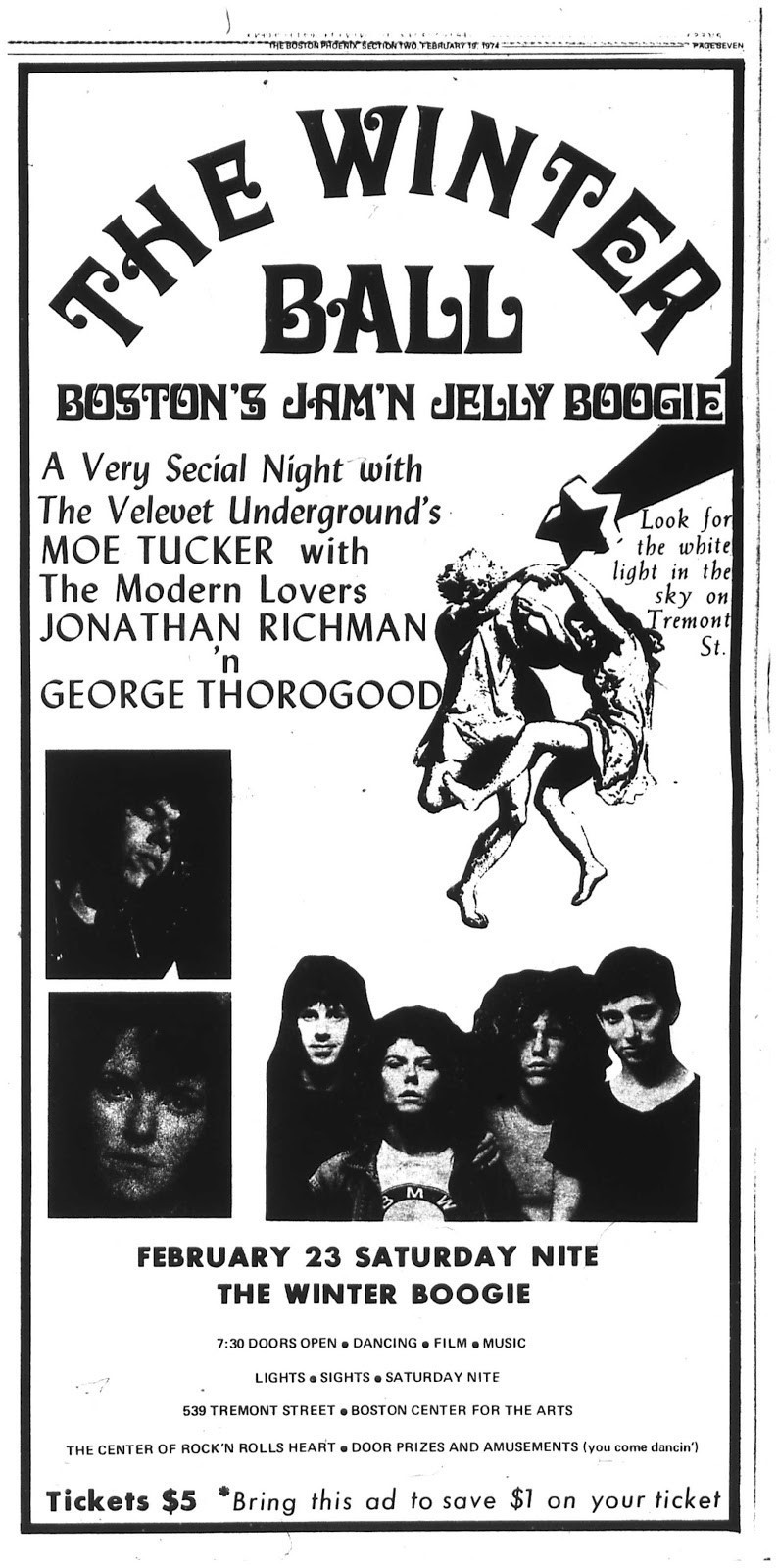
The Modern Lovers - Boston Center for the Arts, Boston, Massachusetts, February 23, 1974
The end of the Original Modern Lovers? This might've been the band's final official gig — thanks to Jesse J for passing along a recently surfaced tape. Jesse calls the recording's quality "atrocious," and he's not wrong (though it's as much the fault of the venue's cavernous acoustics as it is the tape's). Whatever, atrocious quality audience recordings are what Doom & Gloom is all about, am I right? So adjust your ears and take a trip back to a bitter New England winter just about 50 years ago.
Historic/interesting stuff! The set sees the Modern Lovers attempting to bring together their older, more VU-inspired material with the quieter, more innocent songs that Jonathan Richman was writing. There are tunes that will certainly be familiar — "Roadrunner," "Government Center," "Pablo Picasso," etc. And then there are several strong songs that — as far as I know — don't appear anywhere else in the Modern Lovers' discography (officially or unofficially). And hey, it all works pretty well; in some alternate universe, the band might've been able to reconcile their two sides and finally record a proper debut LP. It was not to be, alas — soon, Jerry Harrison would head back to Harvard to get his master's degree in architecture. And today, he is renowned as one of the world's greatest architects ... right???
Of course, we have to note the truly bonkers lineup — a heretofore unknown alignment with the Velevet (sic) Underground and George Thorogood galaxies. Though if the description below is correct (though the source says the date was Valentine's Day), Moe Tucker didn't even get to play because of George. That's truly b-b-b-b-bad. But, as Jesse pointed out, Jonathan and Moe did make it into the studio a few days later to record their charming rendition of the VU's "I'm Sticking With You." Was Moe's band really called the Bloody Virgins?! Hmmm, further investigation is warranted.
An eyewitness account? Although the Modern Lovers broke up in 1973, they reformed in '74 (maybe late '73) with a different drummer but that didn't last long because the drummer hated Jonathan. They did at least one concert: Valentine's Day 1974. I was there early with Jonathan so I got to see all the sound checks for all three bands. Unfortunately, the idiot promoters let the mediocre opening band, George Thoroughlynogood and the Delaware Destroyers, play for one hour and 45 minutes. They should have had 25 minutes max. Thus, the Modern Lovers could only play one hour. And the second band couldn't play at all, which is very unfortunate, as it was Mo Tucker's excellent (and totally unknown) all-girl band the Bloody Virgins (but me and Jonathan got to watch their excellent 25-minute sound check). Seven or either years ago, an internet music forum was discussing Mo, and I talked about seeing that band. A noted music critic (and friend of Mo) was pissed off and said that Mo never had any such band and that I was a liar. Luckily, I still had the concert ad and uploaded a photo of it to the forum.
Ernie Brooks: At one of the last gigs we did, when we played “Roadrunner,” we still didn’t have a record out, but that was always a catchy song, and we actually got some applause—and then Jonathan said, “People like that song too much; I don’t think we should do it anymore….” I think it was just part of Jonathan’s natural inclination that when things seemed to be going well—to go against it. He was very contrary. He was very difficult. I mean, anybody who is on to something new has some element of being a contrarian, because they’re rejecting the status quo. They’re doing something in the way they’ve figured out how to do it—and they don’t want to hear something different, even if it could make things better. When Jonathan said, “I won’t play 'Roadrunner' anymore,” it was pretty much the classic case—you can’t really get any more contrarian than that.
20 notes
·
View notes
Text
Rosalind Russell - The Miracle Woman
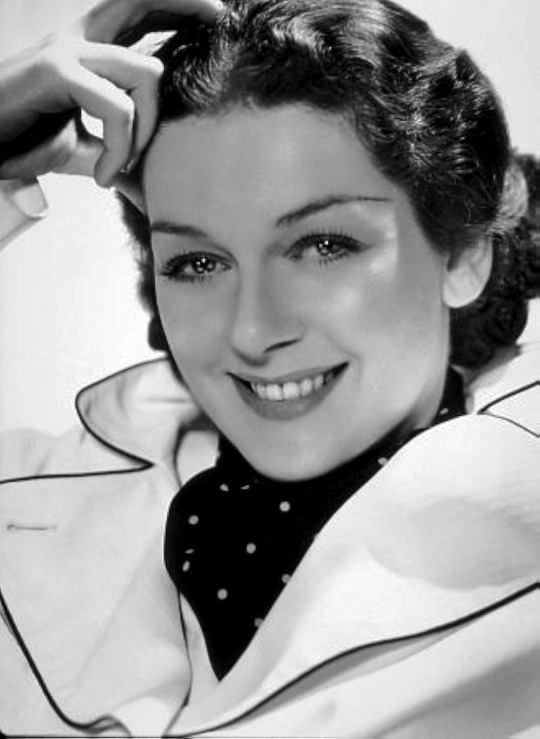

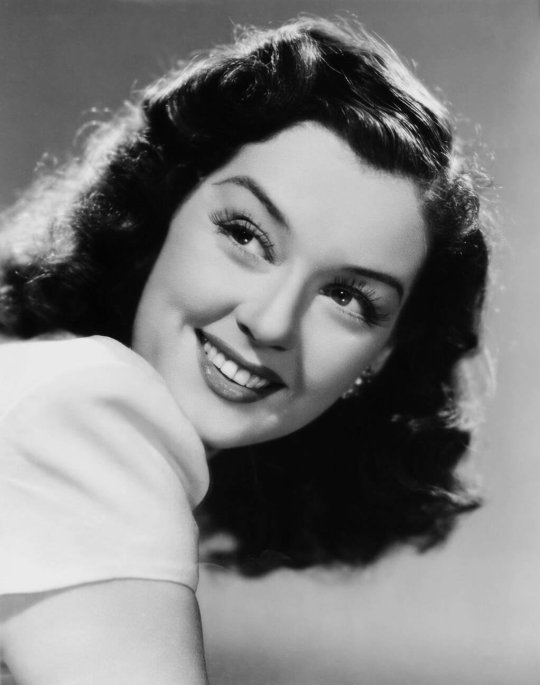


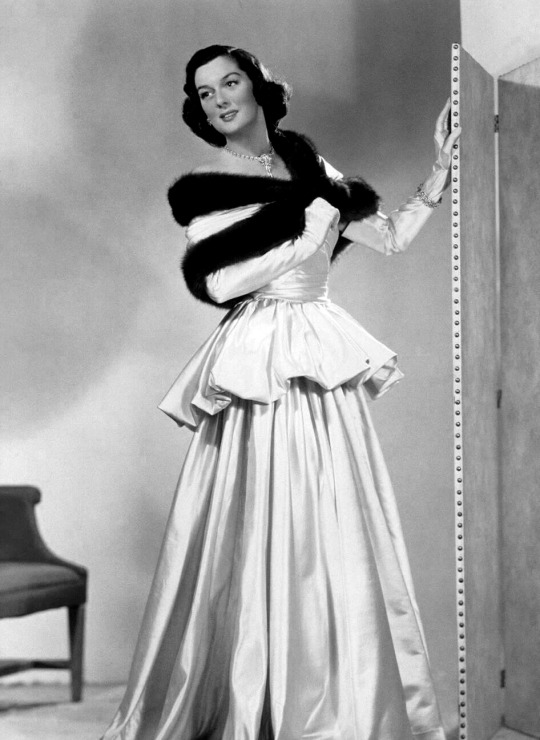

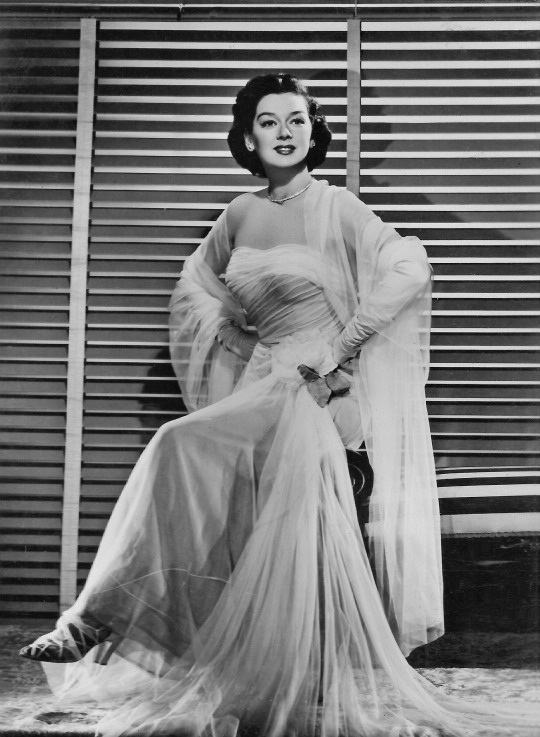




Catherine Rosalind Russell (born in Waterbury, Connecticut on June 4, 1907) was an American actress known for playing sassy, wisecracking women in 1930s and '40s comedies. Despite going through postpartum depression, the deaths of her siblings, breast cancer, and rheumatoid arthritis, she thrived as a charismatic actress on film and the stage, earning the nickname "The Miracle Woman.”
Raised in a strict Irish-American, Catholic family. She attended Rosemont College and Marymount College, before graduating from the American Academy of Dramatic Arts in New York City, unbeknownst to her parents who believed she was studying to be a speech teacher.
Against parental objections, she began her career as a fashion model and took acting jobs in upstate New York, Connecticut, and Boston before eventually appearing in Broadway.
In 1933, Russell went to Los Angeles, where she was hired as a contract player for Universal Studios but did not appear in a movie. Unhappy at Universal, she moved to Metro-Goldwyn-Mayer, where she broke through in the classic screwball comedy His Girl Friday (1940), directed by Howard Hawks.
She took a break after giving birth from her career, but made a comeback with RKO Pictures and then with Columbia Pictures. She continued to appear in critically acclaimed movies and Broadway shows through the mid-1960s, including the title role of the long-running stage comedy Auntie Mame (based on a Patrick Dennis novel) as well as the 1958 film version.
After years of battling breast cancer and even getting a double mastectomy, she died at her home in Beverly Hills, California at 69 years of age. Months after her death, she was honored by her acting colleagues with the “Interlude With Rosalind Russell” at the Shubert Theater in Broadway.
Legacy:
Nominated four times for the Academy Award for Best Actress for her performances in My Sister Eileen (1942), Sister Kenny (1946), Mourning Becomes Electra (1947), and Auntie Mame (1958)
Won all five of her Golden Globe Award for Best Actress nominations: Sister Kenny (1946), Mourning Becomes Electra (1947), Auntie Mame (1958), A Majority of One (1961), and Gypsy (1962)
Won the 1953 Tony Award for Best Actress in a Musical for Wonderful Town and was nominated for the 1957 for Best Actress in a Play for Auntie Mame
Nominated for the 1959 BAFTA Award for Best Foreign Actress
Won the Golden Apple Award in 1942 for Most Cooperative Actress
Awarded the Look Magazine Award for Film Achievement Award in 1947
Covered Time magazine in 1953
Was the namesake of the Rosalind Russell State Theater in her hometown in 1955
Wrote the story for the film The Unguarded Moment (1956) and adapted the novel, The Unexpected Mrs. Pollifax, into the screenplay for Mrs. Pollifax-Spy in 1971, under the pen name C.A. McKnight
Won the Golden Laurel for Top Female Comedy Performance for Auntie Mame (1958) and was nominated five more times
Presented with a medallion by the National Conference of Christians and Jews in 1962
Honored for her distinguished service by the UCLA in 1964
Named the Woman of the Year by Hasty Pudding Theatricals, a student society at Harvard University, in 1964
Is the recipient of the Floyd B. Odlum Award by the Arthritis Foundation in 1971
Appointed by Congress to serve on the National Commission on Arthritis and Related Musculoskeletal Diseases during the 1970s
Received the Golden Plate Award of the American Academy of Achievement in 1972
Appeared in John Springer's "Legendary Ladies" series at The Town Hall in 1973
Awarded the Jean Hersholt Humanitarian Award in 1973 by the Academy for her extensive charity work
Presented her with the National Artist Award in 1974 by the American National Theater and Academy
Awarded the Life Achievement Award in 1975 by the Screen Actors Guild Awards
Hosted by First Lady Betty Ford at the White House in 1976
Honored with the Rosalind Russell Week in 1977 by Los Angeles Mayor Tom Bradley
Co-authored her autobiography, Life Is a Banquet, in 1977
Is the namesake of the Rosalind Russell Medical Research Center for Arthritis at the University of California, San Francisco, created by a Congress grant in 1979
Inducted into the Connecticut Women's Hall of Fame in 2005
Ranked #28 on Premiere magazine's 100 Greatest Performances of All Time in 2006 for His Girl Friday (1940)
Honored as Turner Classic Movies Star of the Month for July 2008
Inducted in the Online Film and Television Association Film Hall of Fame in 2014
Was the subject of a 2016 exhibit at the Mattatuck Museum in her hometown
Honored by the Berlin Film Festival‘s 27-movie tribute in 2022
Has a star on the Hollywood Walk of Fame in the 1700 block of Vine Street for motion picture

#Rosalind Russell#The Miracle Woman#Roz Russell#Auntie Mame#Silent Films#Silent Era#Silent Film Stars#Golden Age of Hollywood#Film Classics#Old Hollywood#Vintage Hollywood#Hollywood#Movie Star#Hollywood Walk of Fame#Walk of Fame#Movie Legends#hollywood legend#movie stars#1900s#28 Hollywood Legends Born in the 1900s
14 notes
·
View notes
Text

Sarah Neville: Stepping into Rita Charon’s studio, in a Jazz Age-era building in Greenwich Village, I get a quick impression of a white-walled space bathed in the sunshine from two large windows that offer a sweeping view over the Lower Manhattan skyline. Everything in the room seems considered, from the Bach playing in the background to the paintings on the walls. One of them, “The Doctor”, is an idealised Victorian depiction of a devoted medic ministering to a child while anxious parents look on. It used to hang in Charon’s father’s office.
My meeting with Charon, founder of the “narrative medicine” movement that trains health professionals to use the power of storytelling in their work, is one I’ve been contemplating for 20 years. How, I’ve wondered, can such a humane approach fit into the time- and cash-constrained world of 21st-century healthcare? And who is this woman who, sometimes unsung, has done so much to change the way we think about the doctor-patient relationship?
Then, just as we sit down, I realise I’m setting out to tell the story of a practised assimilator of other people’s stories. At the core of her work, she says, is “what happens in the actual [moment of] two humans sitting, contacting one another with language, with the embodied self”. So we begin. Charon graduated from Harvard Medical School in 1978 and began practising general medicine. In the late 1980s, she started doctoral studies at Columbia University, focusing on Henry James and the role of literature in medicine. The work of the second half of her life has been to bring these two superficially oppositional realms together. She believes the emotional and imaginative insights contained in literature, art and music can transform the way healthcare workers treat patients and each other. Around 1990, she began teaching narrative medicine at Columbia and in 2009 launched a masters degree in the subject, the first of its kind. Since then, her approach has been deployed by healthcare practitioners across the US and abroad, from Greece to China. Formal evaluations have shown it improves participants’ capacity for reflection, in one study even reducing racial bias.
Charon tells me that for decades doctors were taught to conform to a model of ‘detached concern’ Her father, a doctor in Providence, Rhode Island, was an important influence. At one point, she goes to a filing cabinet containing all his medical records, which she acquired after he died. This part of his life had always been shut off to her; the close community in which they lived meant confidentiality was especially vital. But it turned out that his files combined the usual medical notations with far more personal references. It seemed to reflect a recognition that ailments could not be divorced from the wider context of their sufferers’ lives. Inspired, Charon began making more fulsome and impressionistic notes about her own patients.
The practised narratologist, she says, can pick up a lot in a short period, even at a time when there is pressure on doctors to keep appointments as brief as possible. “As you develop your skills of attention, you will notice things about your patients. You will be listening at a much higher pitch.” As doctors, the human body is, she says, “our material . . . I’m sitting here looking at you, noticing how you sit in the chair.” Emboldened, I ask what else she has picked up about me. She has spotted that my purple outer coat tones with the pink lining of my jacket: “You have taste because you’re not just helter-skelter putting the aqua with the olive green.” She has noticed my eyes: “Mostly the expression is filled with curiosity.” My sense of her, which deepens over the next three-and-a-half hours, is of a woman with a vast well of compassion, lit by a righteous fury about the inequities of US healthcare. “In Yiddish, we call it the Shanda, which is ‘the shame’. The shame of the system,” she says. “More and more clinicians . . . feel they’re being used by their employers. They know they’re doing shoddy work . . . They get tired of saying, ‘I’m sorry, I can only listen to one complaint per session. Bring that up the next time.’”
Truly listening to patients can be transformative, she says. “Patients on the whole really know what they need.” She recalls a young woman with poorly managed diabetes who arrived in her consulting room angry and frustrated. “I did my routine, which is get away from the computer, put my hands in my lap. Don’t write. Just say, ‘I’m going to be your doctor. Tell me what you think I should know.’” The woman looked as if she was going to cry but pulled herself together and glared. “You really want to know what I need? I need a new set of teeth.”
It was only then Charon noticed she’d had her hand covering her mouth as she talked. She had no upper teeth. Instead of fussing with the woman’s insulin levels, Charon arranged for her to be seen in the university’s dental clinic. “She shows up in a couple of months, and she is dazzling. She started a [catering] business in her house. Her [blood] sugars were better than they had been in a while. And she was much more active — she’s going to parties, she’s dancing! It was such a lesson to me. Why on earth would you start anywhere else but ‘Tell me where we should start’?”
I’m intrigued by the extent to which this approach requires an inversion of the traditional power relationship between doctor and patient. She tells me that for decades doctors were taught to conform to a model of “detached concern”. In fact, “engaged concern is going to get you farther than detached concern. Detachment looks an awful lot like coldness.” Instead, Charon believes in making space for the imagination. “The more you exert your own creativity, the better your medicine will be. It’s making leaps . . . I don’t like the word intuition because it sounds like magic. But the ability to see the known from the unknown — that’s what poetry does.”
In the early 2000s, Charon tried something new. After finishing a consultation and making notes like any doctor would, “I would turn the keyboard and the monitor around and say, ‘I know what I saw. But please finish the note.’ I would leave them alone for five minutes, and they wrote the damnedest things!” A college professor wrote “that she knew that she was a good teacher and that this really gave her pride.” The sentiment astonished Charon because it had not surfaced during their conversations, which had been dominated by the woman’s health woes and difficult relationship with her daughter. An idea occurs. As I am drawing our conversation to a close, I ask her to finish this interview. Is there anything else I should know? She confides that after she quit her practice in 2015 to concentrate on running her programme at Columbia, she felt an overwhelming sense of relief that she could hand over responsibility for her patients. (“Somebody else is going to worry about Lucy.”)
It was several weeks before she identified the gap that had opened up in her life: “I was terribly missing the chance to do random acts of kindness.” As a physician, the scope for moments of generosity is “drastic”, she says, whether ringing a patient’s sister to update her, helping put someone’s socks on after an examination or rubbing the feet of a terminally ill patient. There is something heartbreaking about the disproportionate gratitude these interventions elicit, she says. “I think their expectations for us are so low.”
Narrative medicine can, she suggests, endow clinicians with the ability to see an issue from multiple perspectives, a power she likens to “the compound eye of the fly”. It can help them to understand and value those they care for in all their uniqueness and complexity. “We ought to treat every patient as the deepest mystery,” she says.
Sarah Neville is the FT’s global health editor
#medical practice#Sarah Neville#FT#humanizing medicine#doctor patient relationship#narrative#storytelling#listening#Body Alive#Structural Integration Atlanta
4 notes
·
View notes
Text
THIS DAY IN GAY HISTORY
based on: The White Crane Institute's 'Gay Wisdom', Gay Birthdays, Gay For Today, Famous GLBT, glbt-Gay Encylopedia, Today in Gay History, Wikipedia, and more … November 21



Transgender Day Of Remembrance (since 1999) set aside to memorialize those who were killed due to anti-transgender hatred or prejudice (transphobia). The event is held on November 20, founded by Gwendolyn Ann Smith, to honor Rita Hester, whose murder in 1998 kicked off the "Remembering Our Dead" web project and a San Francisco, California candlelight vigil in 1999. Since then, the event has grown to encompass memorials in hundreds of cities around the world.

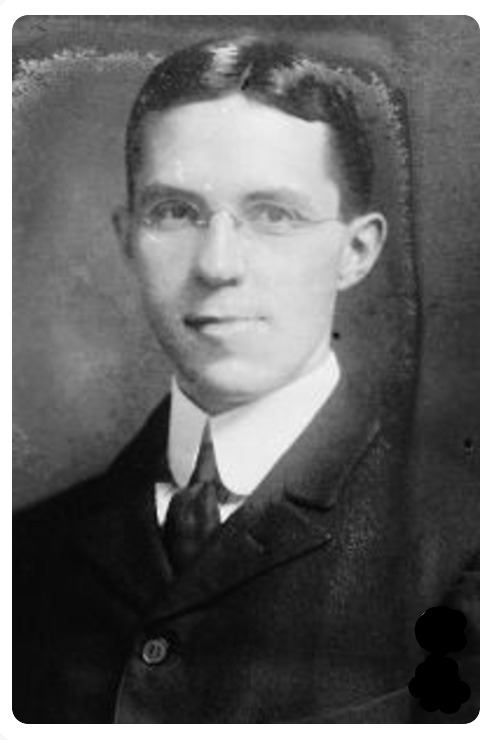
1873 – Daniel Gregory Mason, American composer, born (d.1953); Mason came from a long line of notable American musicians, including his father Henry Mason. He studied under John Knowles Paine at Harvard University from 1891 to 1895, continuing his studies with George Chadwick and Goetschius. In 1894 he published his Opus 1, a set of keyboard waltzes, but soon after began writing on music for his primary career. He became a lecturer at Columbia University in 1905, where he would remain until his retirement in 1942, successively being awarded the positions of assistant professor (1910), MacDowell professor (1929) and head of the music department (1929-1940). He was the lover of composer-pianist John Powell.

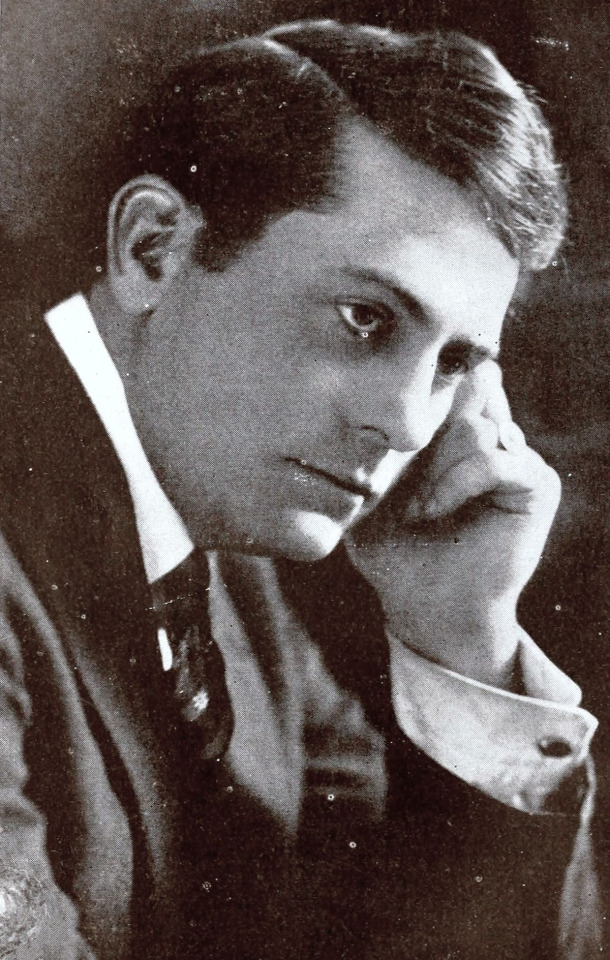
1883 – Edwin August (d.1964) was an American actor, director and screenwriter of the silent era. He appeared in 152 films between 1909 and 1947. He also directed 52 films between 1912 and 1919. He co-founded Eaco Films in 1914.
Edwin was born Edwin August Phillip von der Butz in St. Louis, Missouri, to August and Sarah Butz. He was educated at the Christian Brothers College.
He began working with Biograph Studios in New York as early as 1908 and moved to Hollywood with that company in 1910. He starred in several films by D. W. Griffith, who was also with the company, and continued to work well into the 1930s as a writer and director.
In 1916, he entered his name as a candidate for President of the United States, and spoke out against censorship in cinema. The candidate wasn't taken very seriously, and perhaps that wasn't the point. He didn't like the road that his industry was going down, and wanted to voice his opinion in the hope of change.
A co-star, Blanche Sweet, would later bluntly state: "He was a homo." He owned a chicken ranch at 648 South Figueroa in Hollywood and was friends with gay silent film star J. Warren Kerrigan and most likely Kerrigan's long time partner James Vincent.
Edwin passed away from cerebral metastatic disease on March 4, 1964 at the Motion Picture County Hospital in Woodland Hills, Los Angeles County, California.

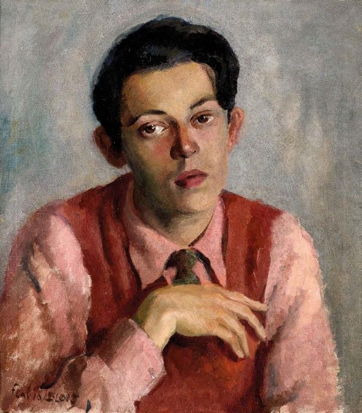
1916 – James Pope-Hennessy (d.1974) was a British biographer and travel writer.
James Pope-Hennessy was born in London on 20 November 1916, the younger son of Ladislaus Pope-Hennessy, a soldier from County Cork, Ireland, and his wife, Una, the daughter of Arthur Birch, Lieutenant-Governor of Ceylon. He was the younger of two sons; his elder brother, John Pope-Hennessy, was an English art historian, museum director and writer of note. James came from a close-knit Catholic family and was educated at Downside School and at Balliol College, Oxford, but generally showed a lack of interest in formal education and did not enjoy his time at either Downside or Oxford.
Largely owing to his mother's influence, he decided to become a writer and left Oxford in 1937 without taking a degree. He went to work for the Catholic publishers Sheed and Ward as an editorial assistant. While working at the company's offices, in Paternoster Row in London, he worked on his first book, London Fabric (1939), for which he was awarded the Hawthornden Prize. During this period, he was involved in a circle of notable literary figures including Harold Nicolson, Raymond Mortimer and James Lees-Milne.
He left the publishers in 1938 when his mother found him a job as private secretary to Hubert Young, the Governor of Trinidad. Although his time abroad provided the material for his later West Indian Summer (1943), he disliked both the West Indies and the atmosphere of Government House. The outbreak of the Second World War gave him an excuse to return to Britain, where he enlisted as a private in an anti-aircraft battery under the command of Sir Victor Cazalet. Rising through the ranks, he was transferred to military intelligence, given a commission and spent the latter part of the war as a member of the British army staff at Washington.
Pope-Hennessy enjoyed his time in the United States and made many friends there. After the end of the war he wrote an account of his experiences in America. On his return to London in 1945 he shared a flat with the British intelligence officer Guy Burgess, who later defected to the Soviet Union. He had a brief spell as the literary editor of The Spectator between 1947 and 1949, before he decided to travel to France and write Aspects of Provence, which was published in 1952.
He would eventually establish himself as one of the leading biographers of his time; his first effort in this direction being a two-volume biography of Monckton Milnes that appeared in 1949 under the titles The Years of Promise and The Flight of Youth. This was followed by further biographies of the Earl of Crewe and of Queen Mary, for which he was created Commander of the Royal Victorian Order in 1960. He also wrote a life of his grandfather, the colonial governor John Pope Hennessy, under the title Verandah (adapted as a documentary for BBC Television under the title "Strange Excellency", 1964), followed by an account of the Atlantic slave traffickers, Sins of the Fathers (1967).
In 1970, he took out Irish citizenship and went to live at Banagher in County Offaly, and during the next few years produced authoritative biographies of both Anthony Trollope and Robert Louis Stevenson. Trollope himself had chosen James' grandfather, John Pope Hennessy, as the basis for the character Phineas Finn in his novel of the same name. Robert Louis Stevenson was published posthumously and without revision in 1974. He became a popular figure in Banagher, evidenced by the fact that he was asked to adjudicate at a local beauty pageant and the horse fair, the oldest in Ireland. On being given a large advance he returned to London in 1974 to begin work on his next subject, Noël Coward.
Despite being a successful professional writer, Pope-Hennessy was careless with money. He suffered a series of financial crises and often relied on the goodwill of friends to get him by. A homosexual, he was a heavy drinker and frequented back-street bars and shady pubs where he mixed with a rough crowd, associations that eventually contributed to his death when he was brutally murdered on 25 January 1974 in his London flat by three young men. He had been sexually acquainted with one of them.

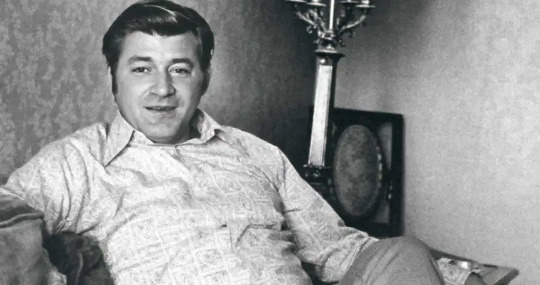
1941 – Oliver Sipple, the man who saved President Gerald Ford's life, was born today.
Sara Jane Moore attempted to assassinate U.S. President Gerald Ford outside the St. Francis Hotel in San Francisco, just seventeen days after Lynette "Squeaky" Fromme had also tried to kill the president. Moore was forty feet away from Ford when she fired a single shot at him. The bullet missed the President because bystander Oliver Sipple grabbed Moore's arm and then pulled her to the ground, using his hand to keep the gun from firing a second time. Sipple said at the time: "I saw [her gun] pointed out there and I grabbed for it. I lunged and grabbed the woman's arm and the gun went off." The single shot which Moore did manage to fire from her .38-caliber revolver ricocheted off the entrance to the hotel and slightly injured a bystander.
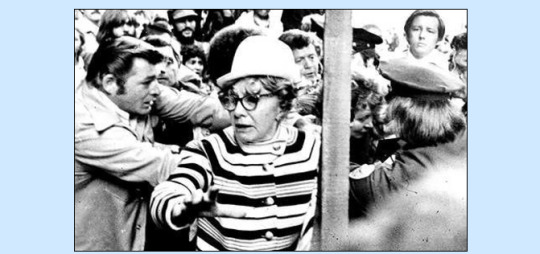
Sipple goes for the gun.
Sipple, a decorated Marine and Vietnam War veteran, was immediately commended by the police and the Secret Service for his action at the scene. The news media portrayed Sipple as a hero but would eventually report on his outing by Harvey Milk and other San-Francisco gay activists. Though he was known to be Gay by various fellow members of the gay community, Sipple had not made this public, and his sexual orientation was a secret from his family. He asked the press to keep his sexuality off the record, making it clear that neither his mother nor his employer had knowledge of his orientation; however, his request was not complied with.
The national spotlight was on him immediately, and Milk responded. While discussing whether the truth about Sipple's sexuality should be disclosed, Milk told a friend: "It's too good an opportunity. For once we can show that Gays do heroic things, not just all that ca-ca about molesting children and hanging out in bathrooms." Milk contacted the newspaper.
Several days later Herb Caen, a columnist at The San Francisco Chronicle, exposed Sipple as a Gay man and a friend of Milk. Sipple was besieged by reporters, as was his family. His mother, a staunch Baptist in Detroit, refused to speak to him. Although he had been involved with the Gay community for years, even participating in Gay Pride events, Sipple sued the Chronicle for invasion of privacy. President Ford sent Sipple a note of thanks for saving his life. Milk said that Sipple's sexual orientation was the reason he received only a note, rather than an invitation to the White House.
Sipple filed a $15 million invasion of privacy suit against Caen, seven named newspapers, and a number of unnamed publishers, for publishing the disclosures. The Superior Court in San Francisco dismissed the suit, and Sipple continued his legal battle until May 1984, when a state court of appeals held that Sipple had indeed become news, and that his sexual orientation was part of the story.
According to a 2006 article in The Washington Post, Sipple went through a period of estrangement with his parents, but the family later reconciled with his sexual orientation. Sipple's brother, George, told the newspaper, "(Our parents) accepted it. That was all. They didn't like it, but they still accepted. He was welcomed. Only thing was: Don't bring a lot of your friends."
Sipple's mental and physical health sharply declined over the years. He drank heavily, gained weight to 300 lb (140 kg), was fitted with a pacemaker, became paranoid and suicidal. On February 2, 1989, he was found dead in his bed, at the age of forty-seven. Earlier that day, Sipple had visited a friend and said he had been turned away by the Veterans Administration hospital where he went concerning his difficulty in breathing. His $334 per month apartment near San Francisco's Tenderloin District was found with many newspaper clippings of his actions on the fateful September afternoon in 1975. His most prized possession was the framed letter from the White House.
Sipple held no ill will toward Milk, and remained in contact with him. The incident brought him so much attention that, later in life, while drinking, he would regret grabbing Moore's gun. Sipple, who was wounded in the head in Vietnam, was also diagnosed paranoid schizophrenic according to the coroner's report.
Sipple's funeral was attended by 30 people, and he was buried in Golden Gate National Cemetery in San Bruno, California. A letter addressed to the friends of Oliver Sipple was on display for a short period after his death at one of his favorite hangouts, the New Belle Saloon:
"Mrs. Ford and I express our deepest sympathy in this time of sorrow involving your friend's passing..." President Gerald Ford, February, 1989
In a 2001 interview with columnist Deb Price, Ford disputed the claim that Sipple was treated differently because of his sexual orientation, saying: "As far as I was concerned, I had done the right thing and the matter was ended. I didn't learn until sometime later — I can't remember when — he was Gay. I don't know where anyone got the crazy idea I was prejudiced and wanted to exclude Gays."


1990 – A London judge convicted 14 gay men of committing criminal assaults upon themselves because of their participation in S&M. All 14 receive prison sentences.


1998 – John Geddes Lawrence and Tyrone Garner of Texas were ordered to pay fines of $125 each after being arrested for having sex in their home. The couple refused to pay and announced they would challenge the Texas sodomy law - initiating what became known as the historic "Lawrence vs Texas" Supreme Court decision which decriminalized homosexual sex.


4 notes
·
View notes
Text
RIP David Lynch 1946-2025
This year only just begun but boy does this one hurt! Visionary of film, TV, art, and music David Lynch has died at 78. The news was announced via Lynch's Facebook page (is it is, in fact, not true - I'll be taking this down). Last year it was announced that he was homebound, but open to directing remotely.

Lynch in the red room
I discovered his work around 1990 when Twin Peaks became a national phenomenon and I discovered a lot of his other work. He was truly an artist in every sense of the word. He often felt that he said so much with his work that it was hard to talk about it in interviews afterwards as the film was the final statement. In 2015, I had a screening at PhilaMOCA near where he lived during his time in Philly and they had a mural of him outside.

Eraserhead mural outside PhilaMOCA in Philadelphia
In the mid-60s, Lynch actually did a year in Boston at the School of the Museum of Fine Arts, where his roommate was actually Pete Wolf, pre-J. Geils Band. Imagine the conversations the two of them must've had!?! He eventually made his way to art school in Philadelphia. To say that environment had an impact on his work would be an understatement. I have a copy of The Short Films of David Lynch compilation, which contains a lot of his early short films made between 1967 and 1974. Even then, he was developing a unique visual style. But he truly announced himself with his feature film debut 1977's Eraserhead. It became a huge cult film, playing midnight screenings for years to come. It also influenced musicians like The Pixies and Talking Heads. I picked up a bootleg circa 2000 that was dubbed from a Japanese laserdisc, so much of my viewing experience with it is with subtitles. I lent that to a number of friends in college too. Now it is available from Criterion, but at the time, it was quite a find to score a copy and not have to go to Harvard Square at midnight to see it. I can’t even say I fully get or understand this film, but one thing is clear: you can’t turn away from it!

Isabella Rossellini being directed by Lynch on Blue Velvet
In the 80s, he got bigger canvases and directed Elephant Man and the adaptation of Dune. The later tends to get a bad wrap because of the amount he had to pack into one movie, whereas Denis Vileneuve had the luxury of splitting it into two movies. But credit where it's due, Lynch tried to make a three hour film and the studio cut it down, but the final film had its moments. Around this time, Lynch was actually offered the chance to direct Return of the Jedi and declined. Can you imagine that? But in 1986, his magnum opus was Blue Velvet released. It is almost like a greatest hits of Lynch elements: film noir, femme fatale, surrealism, gruesome imagery set against pleasant imagery, and excellent use of music. It’s a combination of a great story and screenplay combined with Lynch’s trademark bizarre style (”want to see the chicken walk?”). But the entire cast is pitch perfect and Lynch pushed the envelope further than 99% of most directors in the 80s. This is one of my 15 favorite films of all time. In 2021, I returned to movie theaters for the first time in over a year and I saw Blue Velvet at Coolidge Corner Theatre. A very special occasion with a very special movie!

me at the Twin Peaks’ red room set at the 2019 Rock and Shock.
Lynch collaborated with Mark Frost to create TV's Twin Peaks (ABC 1990-1991), one of the greatest and edgiest network TV shows ever. The constant theme in Blue Velvet of there being more than meets the eye in the seemingly perfect suburban community is something he expanded on with Twin Peaks. The series became a cultural phenomenon. Everyone wanted to know “Who Killed Laura Palmer?” in 1990. I, myself, did not actually start watching the series until the fall, and then I caught up on all the episodes I missed and I was hooked. I remember reading the books they came out with like the Laura Palmer Diaries. The series came to a bizarre end in June 1991. After the series ended, Lynch did a prequel movie Twin Peaks: Fire Walk with Me. Fans of the series were frustrated that this prequel, about the last seven days of Laura Palmer’s life, didn’t tie up any loose ends. It more or less was a movie made up the pieces that came into play from the series and from the book The Secret Diary of Laura Palmer. But that doesn’t mean it was bad, by any means. A lot of fans either didn’t get it or didn’t care now that they knew who the killer Bob was from the series. I dug it. It had all of Lynch’s trademark surrealism and a great performance from Sheryl Lee. In 2017, Lynch and much of the cast reunited for the Showtime limited series Twin Peaks. The series got even weirder and more bizarre when it went to cable. I named it one of my Top 10 TV Shows of the 2010s.

Bill Pullman and Lynch on Lost Highway
He brought his style to the 1990 road movie Wild at Heart, which was awesome! In 1997, he returned to film noir with Lost Highway. When this was released, I was recuperating from illness and when I felt well enough I went into NYC and saw this at the Chelsea Cinema. The story of this seemingly normal couple played by Bill Pullman and Patricia Arquette whose lives are shaken when a mysterious VHS tape of their house shows up one day. Things get weirder when a mystery man played by Robert Blake (with no eyebrows I might add) approaches Pullman at a party and says he is at their house right now. From there it delves knee-deep into Lynchian surrealism and modern film noir. It features a killer score from Trent Reznor too. It is definitely out there and not for everyone. But the more people I talk to over the years have hailed this as one of Lynch’s best. Then Lynch did a complete left turn with The Straight Story, a G-rated simple film about a man traveling across country on a tractor. A beautiful film that's unlike any others of his.
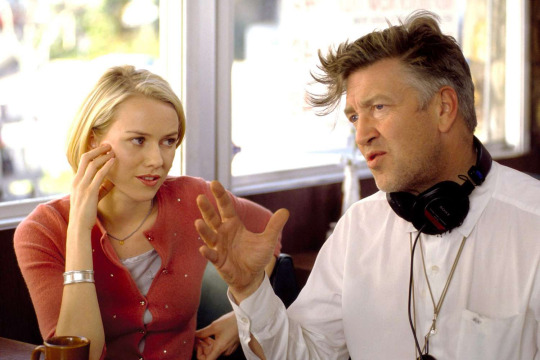
Naomi Watts and Lynch on Mulholland Drive
In the 00s, Lynch turned his attention to the dark side of Hollywood with another noir Mulholland Drive. Even more than the movie itself, I recall seeing it at the movies with a friend and his friend and afterwards us talking over drinks trying to make sense of what we just saw. Great movie, but tons of Lynch WTFery! Today, it is hailed as one of the greatest of this century. In 2006, he continued the themes of Hollywood's dark side with the underrated Inland Empire. He also broke the internet with his daily weather reports, where he read the day's weather in his unique voice.

Lynch as John Ford in The Fabelmans
Lynch's acting also deserves a mention. He did small parts in his own films, notably as FBI Chief Gordon Cole on Twin Peaks. In 2017, I interviewed John Carroll Lynch (no relation) about casting David Lynch in his directorial film Lucky and he said "It was entirely his love of Harry Dean Stanton." He also stole the entire film in Steven Spielberg's semi-autobiographical The Fabelmans, where Lynch played director John Ford. That John Ford scene is one of the greatest movie scenes with a filmmaker ever and Lynch brought it!
There have been a number of documentaries exploring the various interpretations and theories of Lynch's work including Blue Velvet Revisited and Lynch/Oz.


Lynch cover stories in EW and Rolling Stone
For me, he was one of the first directors that influenced me. As a teen, I gleaned over books, articles and interviews about him. It was one of the first times, I noticed that a director was on the cover of magazines, not just the cast. But more than that, it was his body of work. There was pure WTFery in his movies and it seemed like there was no story and it was a bunch of crazy stuff, but his movies were very well constructed, they were just structured in such a way to have some crazy out-there surrealism within those stories.
He was nominated for Oscars for directing Elephant Man (also nominated for writing), Blue Velvet and Mulholland Drive, but he only won an Honorary Award in 2020. Putting him in that club of directors like Hitchcock and Kubrick who also never won Oscars for directing. Lynch also recorded music (some were his own soundtracks) and his art work was exhibited in galleries and museums all over the world.
The obit from Variety can be read here!
#david lynch#rip#philamoca#peter wolf#eraserhead#dune#blue velvet#star wars episode vi: return of the jedi#rock and shock#twin peaks#twin peaks: fire walk with me#wild at heart#lost highway#the straight story#mulholland drive#inland empire#lucky#john carroll lynch#the fabelmans#steven spielberg#john ford#film geek
4 notes
·
View notes
Text
Edward Gorey: History of an Eccentric Creator

While styles of artists like Tim Burton, Laika Studios, and Neil Gaiman are widely known, it's notable to me that the adoration for Edward Gorey's distinctive style doesn't always receive the same level of recognition.
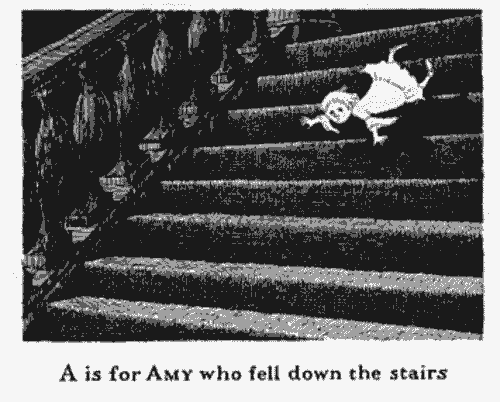
Gorey began drawing at 18 months (!) and taught himself to read by age three. He skipped several grades and engaged in various school activities and publications, he left Francis Parker School with high scores, earning scholarships both to Harvard and Yale. At 17, with pending WWII draft notices, Gorey briefly studied art at the Art Institute of Chicago before joining the U.S. Army during World War II, serving until after the war's end, mainly at the Dugway Proving Grounds in Utah.
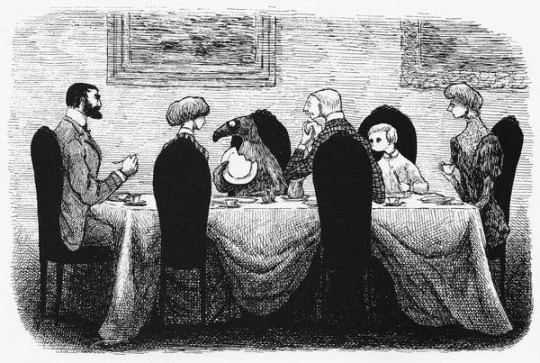
In 1946, Edward Gorey enrolled at Harvard, majoring in French Literature, and delved into various artistic pursuits, including publishing stories, poems, designing sets, and directing for the Poets Theatre. Despite somehow ending up on both the Dean's List and under constant threats of expulsion, he excelled. In 1953, upon being offered a position at Doubleday Anchor in New York City, Gorey became a prominent figure in design, illustrating over fifty covers and gaining recognition as a major commercial illustrator. After stints at other publishing houses, he turned freelance in the early 1960s, illustrating well over five hundred books for others while also crafting his own works. His career began with the 1953 book "The Unstrung Harp," a precursor to graphic novels, praised by Graham Greene and recognized as a "minor masterpiece" by The London Times. Edmund Wilson's acclaim in The New Yorker marked the start of Gorey's exceptional fifty-year career, resulting in 116 written and illustrated works.
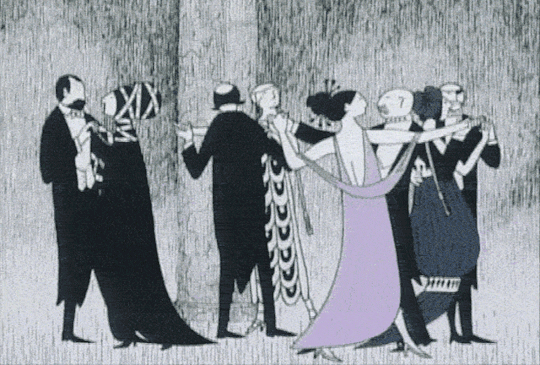
From displaying art at the Francis Parker School in 1939 to showcasing at the Mandrake Bookshop during his Harvard years and even as far as California, Edward Gorey's artistic journey was expansive. In 1967, Gotham Book Mart invited Gorey to exhibit at its newly opened second-floor art gallery, a collaboration that spanned thirty-two years. This partnership led to occasional publications of new Gorey works by Gotham Book Mart and collaborations with figures like Samuel Beckett and John Updike. Gorey's love for theater blossomed into involvement in off-Broadway productions, summer Cape Cod plays, and the 1973 design of "Dracula" for a Nantucket theater. The Broadway adaptation, "Edward Gorey’s Dracula," opened in 1977, achieving immense success, earning two Tony Awards, running for nearly three years, and touring globally.
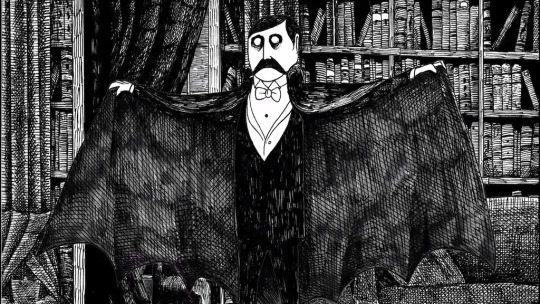
Having frequented Cape Cod for years, Gorey's connection to the region deepened in 1979 when he used royalties from the New York Dracula production to acquire a two-century-old sea captain's home in Yarmouth Port. By 1983, he made the decision to bid farewell to New York City and establish his residence on the Cape. Amidst this shift, Gorey intensified his involvement in small experimental plays, maintained an active presence in publishing, art exhibitions, etching creations, and juggled a demanding workload of commercial projects. In 1980, he was commissioned to design animated introductions for Boston Public Television's Mystery! series, a collaborative effort with animator Derek Lamb that remains an enduring testament to Gorey's artistic legacy, encapsulating the essence of several of his works in a concise half-minute.
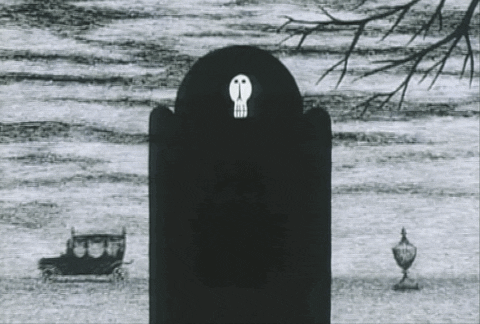
Gorey, known for maintaining the mystery and refusing to "explain" his books, revealed a glimpse into his philosophical inclinations during a single interview. When pressed about his beliefs, he identified as a Taoist, leaning towards surrealism. Examining his early teen art unveils evident influences from Di Chirico, Dali, and Ernst
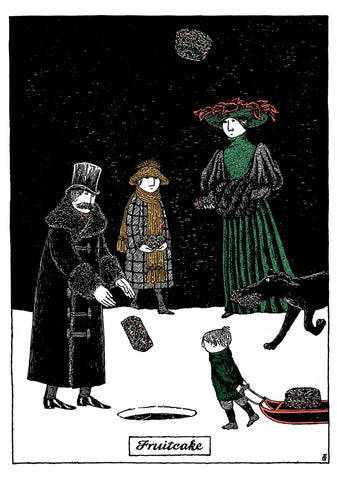
Edward Gorey's multifaceted body of work, encompassing humor, complexity, seriousness, and provocation, has solidified his position as a significant American figure in literature, art, and theater that should always be remembered!
#EdwardGorey#GoreyArt#GoreyIllustrations#DarkHumor#LiteraryIcon#GothicArt#MacabreMagic#ArtisticLegacy#LiteraryMystery#InnovativeDesigns#TaoistSurrealist#EnigmaticArtist#TimelessTales#CreativeInspiration#GoreyWorld#IllustrationMasterpiece#LiteraryTreasure#ArtisticInfluence#GoreyLegacy#LiteraryLegend#IconicImagination#GoreyAesthetic#CulturalInfluence#VisualStorytelling#ArtisticJourney#GoreyAnimations
12 notes
·
View notes
Text
Watercolor Bar Mitzvah Card
Over the weekend, my son was graciously invited to a classmate’s Bar Mitzvah. Nobody in my family has ever attended one, so we weren’t quite sure what to expect. Luckily, we’ve got a few friends (and a couple of art students) that know the ropes when it comes to such a special event so they walked us through the process. And it was super interesting. I’m actually bummed I didn’t get invited! My kiddo said it was really interesting to listen to the ceremony and watch his classmate read from the torah, reciting difficult passages. And both the luncheon and afterparties were more on the scale of a wedding is what he said. Tons of food, dancing, laughs, desserts.
From the sounds of it once he got home to seeing all the photos taken, it sure did look like a fabulous event!
I ended up painting this kiddo a card because I wanted to make something special for him (even though I never have even met this kid nor his family). And I’m happy with how it turned out, being the first time I’ve ever created one! Come take a look at the process and final result.
#watercolors#adult watercolor classes#beginner watercolor classes#in-studio watercolor art class#online watercolor classes#YouTube Artist#YouTube Video#Bar Mitzvah card#Art Studio Harvard MA#handmade in Harvard#Harvard Art Studio#Harvard MA art studio#Art Studio Littleton MA#Littleton Art Studio#Littleton MA art studio#Glimmerbug#Glimmerbug Handmade Art#glimmerbugartstudio#glimmerbughandmadeart
0 notes
Text

OOC INFO
Name/Alias: Arrow Pronouns: She/They Age: 31 Timezone: PST
IC INFO
Character Name: Laure Rothschild Stephens Character Age: 47 Character Birthday (with year): April 7, 1977 Gender & Pronouns: Cis Woman; she/her Affiliation: Tartarus Occupation: Underboss (Hemera); Auctioneer Faceclaim: Melanie Lynskey
BIOGRAPHY
The Rothschild name has been connected with the fine arts scene for generations throughout Europe and New England. Her father, several aunts and uncles, and many more cousins hold various roles within the industry, from collectors to curators to restorers. Not joining the family business was never an option for Laure, but she never contemplated the idea to begin with, far too enamored with her cushy lifestyle to ever give it up. The Rothschilds' connections to the MacCabes are innocuous to the public eye, but old loyalties run deep.
While Laure maintains a private studio and collection for her personal art, her professional attention has largely been placed on the business aspect of things. Her family connections open the door to an internship at Grogan, an esteemed auction house in the city. A PhD from Harvard on focusing on 18th and 19th century modern art propels her to new heights, but she soon learns that such connections come with a price. She makes her first sale on behalf of Tartarus at 25, taking over for a deal that one of her cousins botched. The outcome isn't ideal, but better than total failure, and it cements Laure's position as a useful member of the organization.
Her next move is unorthodox, but masterful nonetheless. Orchestrating an 'accidental' meeting is child's play for her, and she simply smiles when Kiri invites her to coffee. She is content to let the other woman believe she is in control. Laure sheds layer after layer of herself, testing her loyalties with every step until she reveals the truth of her connection with Tartarus. By then, they are inextricably linked.
Bringing Kiri into the fold has a secondary effect of boosting Laure's reputation within Tartarus. They become an indomitable pair, between Kiri's product and Laure's access and isn't long before she is elevated to the rank of underboss, taking on the name Hemera. She is loyal to Tartarus, but carves her own domain within the borders of its kingdom. When she learns of a young woman, pulled into the organization because of the mistakes of her father, it strikes a chord in Laure and offers her a place beside her.
It's not life exactly as she envisioned it, but it is markedly hers nonetheless. The years spent climbing to the top have proven to be worth it, and she has no intention of letting any of it go.
2 notes
·
View notes
Text

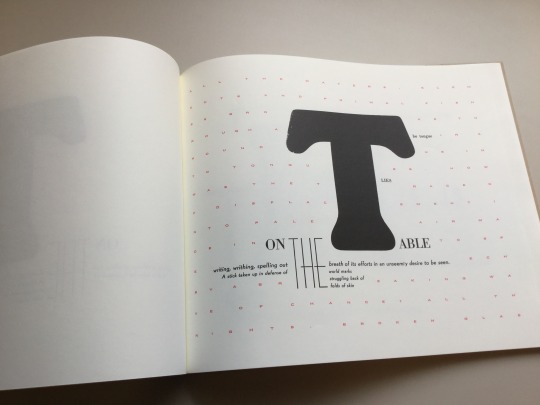
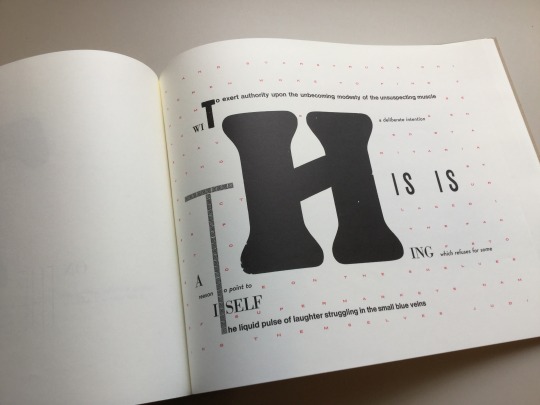
Since 1978, Bow & Arrow Press has resided in a tiny corner of the Adams House, one of a dozen residential Houses devoted to Harvard undergraduate students. It is located in a building at the intersection of Bow and Arrow Streets, which its name originated. For 45 years, Bow & Arrow Press welcomed everybody in the community--students, faculty, staff, alumni, and the Adams House residents--and taught the art of letterpress to anybody who wanted to learn largely free of charge.
This Monday, the movers came and packed the contents of the studio, including the vintage presses and type cases, for storage while the Adams House renewal project takes place. The renewal plan had included the Bow & Arrow Press until April 16th, when Adams House’s faculty deans informed the community that the studio would not move back into their space after renovations are completed in 2025.
For 45 years, the Bow & Arrow Press has been a true community press. Over the years, thousands came to learn to typeset, get their fingers inky, and joyously run the century old letterpress. The creator of this artist’s book, scholar Johanna Drucker, used the press while she was a Harvard Mellon Faculty Fellow in the Department of Fine Arts. Drucker produced the letterpress edition of “The Word Made Flesh” in the winter of 1988-1989 with the assistance and support of James Barondess and Gino Lee, founders of the Bow & Arrow Press. Last Wednesday, Barondess (A.B.’79, Ph.D. ’93) came to the last Open Press Night and shared the early history of the press with the many younger generation printers who attended the event.
Poet Seamus Heaney also became familiar with the Bow & Arrow during his Harvard years, and theater director Peter Sellars was among the first students to get their hands on the press.
You can read more about the Bow & Arrow Press in an article, “The Eviction of the Bow & Arrow Press” written by Craig Lambert on Harvard Magazine.
The word made flesh Drucker, Johanna, 1952- New York, NY : Granary Books, c1996. "This is a facsimile reprint of copy #50 of the original letterpress edition"--Colophon. "The Druckwerk edition was produced in winter 1988-89 at the Bow and Arrow Press"-- HOLLIS number: 990072967770203941
#Bow&ArrowPress#BowandArrowPress#LetterPress#Letterpressprinting#JohannaDrucker#AdamsHouse#CommunityPrintingPress#HarvardFineArtsLibrary#Fineartslibrary#Harvard#HarvardLibrary#harvardfineartslibrary#fineartslibrary#harvard#harvardlibrary#letterpress#letterpress printing#artists books
40 notes
·
View notes
Text
LÉGENDES DU JAZZ
WADADA LEO SMITH, UN INNOVATEUR MÉCONNU
Né le 18 décembre 1941 à Leland, au Mississippi, Ishmael Wadada Leo Smith avait d’abord joué de la batterie, du mellophone (une sorte de cornet) et du cor français avant de passer à la trompette. Enfant prodige, Smith a composé sa première pièce musicale à l’âge de douze ans. Durant ses études secondaires, Smith avait joué et occupé le poste d’assistant-directeur des ensembles de cors et clairons de son high school sous la direction de Henderson Howard.
Smith avait reçu sa première formation musicale de son beau-père, le compositeur et guitariste Alex “Little Bill” Wallace, un des pionniers de la guitare électrique avec le groupe Delta Blues. À l’âge de treize ans, Smith avait d’ailleurs commencé à jouer avec Delta Blues et d’autres groupes traditionnels locaux. Smith avait poursuivi sa formation musicale lors d’un séjour dans l’armée à Fort Leonard Wood, au Missouri en 1963, puis à la Sherwood School of Music de 1967 à 1969 et à la Wesleyan University de 1975 à 1976 où il avait décroché un diplôme en ethnomusicologie.
DÉBUTS DE CARRIÈRE
Après avoir joué avec différents groupes de rhythm & blues, Smith était devenu membre de l’Association for the Advancements of Creative Musicians (AACM) en 1967 avant de co-fonder la Creative Construction Company, un trio mettant en vedette le violoniste Leroy Jenkins et le saxophoniste Anthony Braxton. Dn 1971, Smith avait fondé Kabell, sa propre maison de disques. Smith avait également formé un autre groupe appelé New Dalta Ahkri avec des musiciens d’avant-garde comme Henry Threadgill, Anthony Davis et Oliver Lake.
Dans les années 1970, Smith, tout en pousuivant ses études en ethnomusicologie à l’Université Wesleyan avait continué de jouer avec Braxton. Il avait aussi enregistré avec la Derek Bailey's Company.
ÉVOLUTION RÉCENTE
Devenu Rastafarien au milieu des années 1980, Smith avait commencé à utiliser le nom de Wadada. Également professeur, Smith avait enseigné dans de nombreuses institutions scolaires au cours de sa carrière, dont l’Université de New Haven (1975-76), le Creative Music Studio de Woodstock, dans l’État de New York (1975-78) et le Bard College (1987-93). À partir de 1994, Smith avait enseigné à la Herb Alpert School of Music du California Institute of the Arts, où il avait dirigé le programme d’improvisation afro-américaine jusqu’à sa retraite en 2013.
Malgré sa retraite de l’enseignement, Smith avait continué d’animer des ateliers, des résidences et des classes de maîtres dans des institutions comme l’Université Harvard, le New England Conservatory, la New School of Music, l’Ithaca College et la Georgetown Day School. Smith est également l’auteur de plusieurs traités musicaux, dont Source a New World Music: Creative Music, qui a été publié au Japon en 1976 après avoir été publiée initialement par Kiom Press en 1973. Publiées d’abord en 1981, ses Notes (8 Pieces) ont été rééditées dans une version élargie en Italie en 2015. En 1996, Smith avait également présenté une conférence à Copenhague, au Danemark, sur le concept d’Ankhrasmation devant plusieurs artistes, scientifiques et philosophes. Enregistrée pour la télévision danoise, son entrevue avait été télédiffusée en septembre 1996.
En plus de la trompette et du flugelhorn, Smith jouait de plusieurs instruments non occidentaux comme le koto, le kalimba et l’atenteben, une flûte de banbou originaire du Ghana. Il enseignait également des techniques de fabrication de certains instruments. Très intéressé aux musiques du monde, Smith avait particulièrement étudié les musiques africaines, japonaise, indonésienne, européennes et américaine.
En 1998, Smith et le guitariste Henry Kaiser avaient publié Yo, Miles!, un hommage aux compositions les moins connues de la période électrique de Miles Davis. Dans le cadre de cet album, Smith, Kaiser et les autres membres du groupe avaient enregistré leurs propres versions de classiques de Davis ainsi que des compositions originales inspirées de l’oeuvre du trompettiste. Si les albums suivants de Smith, Sky Garden (2004) et Upriver (2005) avaient été enregistrés avec un autre groupe de musiciens, Michael Manring était toujours le bassiste de la formation. Smith avait également publié plusieurs albums avec son Golden Quartet composé à l’origine d’Anthony Davis aux claviers, de Malachi Favors à la contrebasse et de Jack DeJohnette à la batterie. Après plusieurs changements de personnel, l’alignement permanent du groupe est maintenant formé de Davis au piano, de John Lindberg à la contrebasse et de Pheeroan akLaff à la batterie.
Dans les années 2000, Smith avait enregistré pour la compagnie de disques Tzadik de John Zorn, ainsi que pour Pi Recordings. En 2008, Smith avait enregistré avec son quartet un DVD intitulé Freedom Now. Résident de New Haven, au Connecticut, durant plusieurs années, Smith a contribué à y développer un environnement propice au développement de la musique créative, un concept basé sur l’harmonie spirituelle et l’unification des cultures à travers le monde.
Dans ses compositions, Smith utilisait souvent un système de notation graphique qu’il appelait "Ankhrasmation" et qu’il avait développé à partir de 1965. Smith avait utilisé ce concept pour la première fois en 1967 dans le cadre de l’album ‘’The Bell: Three Compositions of New Jazz’’ d’Anthony Braxton. Le concept d’Ankhrasmation avait joué un rôle déterminant dans le développement de Smith comme artiste, chef d’orchestre et éducateur.
Les concepts musicaux d’Ankhrasmation ont été exposés dans des musées américains majeurs comme The Renaissance Society de l’Université de Chicago qui avait présenté en octobre 2015 la première exposition de ces langages musicaux. En 2016, le Hammer Museum a présenté une exposition intitulée Made in L.A. mettant en vedette les compositions de Smith et lui avait décerné un Mohn Award for Career Achievement en guise de reconnaissance pour son talent et sa résilience. Les compositions de Smith ont également été présentées au Kalamazoo Institute of Arts au Michigan, à la Kadist Art Foundation de San Francisco, au Museum of Rhythm Łódź, en Pologne, et à la Clemente Gallery de New York.
Lauréat de nombreux prix, Smith a notamment remporté en 2008 un FONT (Festival of New Trumpet) Award of Recognition. Il a aussi été finaliste en 2013 pour un prix Pulitzer pour l’album Ten Freedom Summers, une collection de compositions regroupée dans un coffret de 4 CD inspiré du mouvement des droits civiques. L’album s’était mérité plusieurs honneurs, dont un MAP Fund Award (2011), un Chamber Music America New Works Grant (2010) et un National Endowment for the Arts Recording Grant (2010). L’oeuvre était commanditée par la James Irvine Foundation, la Clarence E. Heller Charitable Foundation et de la John Simon Guggenheim Memorial Foundation Fellowship (2009-2010).
Élu compositeur de l’année par le magazine Down Beat en 2013, Smith avait remporté trois ans plus tard un Doris Duke Artist Award et un doctorat honorifique de l’Université CalArts. En 2018, l’American Academy of Religion avait aussi décerné à Smith un Religion and The Arts Award. L’année suivante, Smith s’était également mérité la UCLA Medal, le plus important honneur pouvant être décerné par l’Université de Californie à Los Angeles. La Jazz Journalists Association a accordé plusieurs honneurs à Smith, dont celui de musicien de l’année en 2013 et de duo de l’année (pour sa collaboration avec le pianiste Vijay Iyer), de compositeur de l’année en 2015 et de trompettiste de l’année en 2017 et 2022. En 2022, Smith avait également remporté le Vision Festival’s Lifetime Achievement Award. Il avait aussi obtenu trois bourses du National Endowment for the Arts (en 1972, 1974 et 1981).
Smith a également été élu compagnon de plusieurs institutions comme l’Atlantic Center for the Arts (2001), la Civitela Foundation (2003), la Jurassic Foundation (2008), la United States Artists en 2021 et la Yale Center for the Study of Race, Indigeneity and Transnational Migration (RITM) en 2022. Smith a aussi reçu plusieurs commandes du Los Angeles Philharmonic. L’album de Smith ‘’America’s National Parks’’ avait également été sélectionné comme un des meilleurs albums de 2016 par le New York Times, le NPR Jazz Critics Poll et le magazine The Wire. L’album a aussi été choisi album de l’année dans le cadre du 65e sondage des critiques du magazine Down Beat. Smith avait d’ailleurs fait la couverture du magazine à deux reprises: en novembre 2016 et en août 2017. Smith a également été élu artiste de l’année par le sondage des critiques du magazine Jazz Times en 2016.
En plus d’avoir été interprétées par le groupe de Smith, le Nda-Kulture Ensemble, les compositions du trompettiste ont été interprétées par plusieurs groupes de musique contemporaine dont le RedKoral Quartet, l’Orkiestra Symfoniczna NFM (de Wroclaw, en Pologne), l’AACM-Orchestra, le Kronos Quartet, la Da Capo Chamber Players, le New Century Players, le LA Phil New Music Group, la Chicago Symphony Orchestra Association, la San Francisco Contemporary Music Players, la Contemporary Chamber Players de l’Université de Chicago, le S.E.M. Ensemble, le Southwest Chamber Music, le Del Sol String Quartet, le New York New Music Ensemble et le California E.A.R. Unit.
Durant plus de deux décennies, Smith avait également écrit de la musique pour de nombreux groupes, y compris des oeuvres de longue durée qui prenaient quelques jours pour être interprétées en entier, comme ‘’Ten Freedom Summers’’ (2011, RedCat, Los Angeles), et “Tabligh” pour double ensemble (Golden Quartet and Classical Persian ensemble à Merkin Concert Hall, à New York, en 2006) (Golden Quartet and Suleyman Erguner’s Classical Turkish ensemble (Akbank Music Festival à Istanbul en 2007). La composition la plus imposante de Smith intitulée “Odwira” avait été écrite pour un grand total de douze orchestres et avait été interprétée au California Institute of the Arts en mars 1995. Les oeuvres pour piano solo de Smith ont été interprétées par de nombreux artistes, dont Ursula Opens, Marilyn Crispell, Mr. David Rosenboom and Ms. Vickie Ray. Smith a également composé pour des ensembles de musique classique.
Reconnu à la fois comme trompettiste, multi-instrumentiste, compositeur et improvisateur, Smith a collaboré avec plusieurs sommités du jazz au cours de sa carrière, dont Anthony Braxton, Leroy Jenkins, Roscoe Mitchell, Henry Threadgill, Lester Bowie, Joseph Jarman, Cecil Taylor, Steve McCall, Anthony Davis, Carla Bley, Don Cherry, Jeanne Lee, Tadao Sawai, Muhal Richard Abrams, Ed Blackwell, Kazuko Shiraishi, Han Bennink, Marion Brown, Charlie Haden, Malachi Favors Magoustous, Jack DeJohnette, Vijay Iyer, Ikue Mori, Min Xiao Fen, Bill Laswell, John Zorn, Ronald Shannon Jackson et Frank Lowe. Smith a enregistré plus de cent albums comme leader ou co-leader au cours de sa carrière. Parmi ses plus récentes parutions, on remarque Wadada Leo Smith String Quartets Nos. 1-12 (2022) et The Emerald Duets (avec Pheeroan akLaff, Andrew Cyrille, Han Bennink et Jack DeJohnette également en 2022)
©-2024, tous droits réservés, Les Productions de l’Imaginaire historique
4 notes
·
View notes
Text
Not Another Macallan
With love, Vanessa @choosejoyangel. :) Thank you to @whoevrwhatevr for encouraging me to write. I am grateful.
Author's note: Anything SVU-related belongs to their respective owners. The original character, Christmas Grace Lennox, and everything else belong to me. I am on no other platform besides Tumblr, Vimeo, and Google/YouTube at my handle, @choosejoyangel. Enjoy, angels! :)
Just some positive goodness to brighten your day!
Soundtrack: Queen-You're My Best Friend and Dave Matthews Band-Crush <3 :)
I thought it would be more engaging for the reader to follow Rafael and Rita’s banter if it were written as a transcription. Get cozy as you imagine being in the same room as besties for life, Rafael Barba and Rita Calhoun, reflecting on an evening most likely spent alone, just the two of them starting the night at their favorite ice cream parlor over a banana split debating a case and ending the night keeping each other warm like they have always done since their Harvard Law days. Rita realizes it is time to let Rafael know how much he truly means to her, and that includes showing him he deserves to be happy with the woman he does not want to imagine his life without. Who is this woman? Is it her? Or, is Rita helping her best friend allow himself the chance at true love with someone else?
Rita: Why are you in my kitchen, Rafi? It is your birthday, not mine.
Rafael: You know I hate surprises.
Rita: Then why are you trying to hide your smile?
Rafael: I am not smiling.
Rita: And I am 39.
Rafael: For the sixth year in a row.
Rita: I should have bought you another bottle of Macallan.
Rafael: I liked this gift better, Rita.
Rita: Speak up, babe. Did you lose your speaking voice all of a sudden?
Rafael: I liked this gift better, Rita!
Rita: I heard you the first time, but I wanted everyone still here to know how cuddly you are.
Rafael: You can take the man out of the Bronx.
Rita: But you can’t take the Bronx out of the man. I get it, Rafael. We don’t like letting our guard down. It may work in the courtroom but not in the bedroom.
Rafael: You never had complaints about either of our bedrooms, sweetheart.
Rita: Never!
Rafael: I trust you.
Rita: I trust you too, Rafi.
Rafael: Um, are you up to finish tonight with a bang?
Rita: I don’t think that is a good idea.
Rafael: What is wrong? I’m so sorry. I loved my party. Seeing everyone from work…um.
Rita: And home?
Rafael: Yes.
Rita: If not for her, you and I would celebrate your birthday over a banana split.
Rafael: Her?
Rita: Yes, Mistletoe.
Rafael: You mean Christmas?
Rita: Mistletoe, Christmas, who cares?
Rafael: Her name is Christmas, and yes, you do care.
Rita: Who in their right mind names their kid after a holiday?
Rafael: It’s not important. Leave her alone. She is my friend, Rita.
Rita: Friend, eh?
Rafael: Yes, my friend.
Rita: I have known you for over twenty years, Rafael Barba.
Rafael: And?
Rita: I have not seen that look on your face since, um, well, you know who I am talking about.
Rafael: Yelina?
Rita: Ugh! I thought I told you never to repeat her name in my presence.
Rafael: Come on! Yelina broke my heart, not yours.
Rita: Don’t say her name!
Rafael: Okay!
Rita: Christmas helped me plan your surprise birthday party. She was a big help, considering my caseload. It’s not like she has much to do besides play in her art studio.
Rafael: She works in her art studio, Rita. That is her job, and she is busy, too.
Rita: I know, Rafael. I love it when you defend her. You start blushing, and your green eyes get brighter in defense of what you call her “your friend”?
Rafael: I hate you.
Rita: I hate you too.
Rafael: She helped you?
Rita: Yes, she did. And the feeling is mutual between you and her.
Rafael: Are you psychic now?
Rita: No, I am a woman.
Rafael: Oh, I didn’t know.
Rita: I am trying to tell you that I don’t think it is a good idea for us to have sex anymore, Rafael.
Rafael: You and I can still be friends.
Rita: You will always be my best friend, Rafi.
Rafael: You will always be my best friend, too, Rita.
Rita: Christmas is your best friend now.
Rafael: I am allowed to have two best friends.
Rita: I know. She wants you to be happy, even if it may be you and me. I assured her that you and I are or were what young people like her call “friends with benefits.”
Rafael: She is not that young, Rita.
Rita: You were in high school when she was born, Rafael.
Rafael: It does not bother us; does it bother you?
Rita: No!
Rafael: Will you be happy?
Rita: I am happy, and I am happy for you too. Besides, I am seeing someone.
Rafael: Really? What’s his name?
Rita: She.
Rafael: Well, okay then. What is her name?
Rita: She is a lawyer; that is all I will tell you for now.
Rafael: Please tell me her name before you put a ring on her finger.
Rita: Changing subjects.
Rafael: I was kidding. I do hope to meet her if that is what you want.
Rita: You will be the first to know.
Rafael: I think Christmas is still here.
Rita: Of course she is. I can smell the holly from here.
Rafael: Rita!
Rita: If you want to help in my kitchen, make some coffee for us, Rafael.
Rafael: I don’t want to ask her to leave yet.
Rita: The coffee is for her, too, silly. If she leaves, you leave with her. You two live near each other. Oh, you have protection?
Rafael: Rita, I am not discussing my sex life with you.
Rita: She is cute. Ask her to spend the night with you.
Rafael: Rita.
Rita: I don’t want to find out you didn’t at least give her a kiss goodnight. And you know I am not talking about a chaste kiss between friends, Rafael Barba!
Rafael: You won’t, Rita Calhoun.
Rita: She and I are friends now.
Rafael: Hmm.
Rita: Rafael and Christmas sitting in a tree…
Rafael: I will meet you in the sitting room.
Rita: You better hide that blush of yours.
Rafael: Rita.
Rita: What?
Rafael: Thank you.
Rita: You’re welcome.
Rafael: I love you, Rita.
Rita: I love you too, Rafael.
Rafael: My wish came true.
Rita: Yes, it did. Happy Birthday, Rafael. Now, get out of my kitchen.
⋆˚✿˖°⋆˚✿˖°⋆˚✿˖°⋆˚✿˖°⋆˚✿˖°⋆˚✿˖°⋆˚✿˖°⋆˚✿˖°⋆˚✿˖°⋆˚✿˖°⋆˚✿˖°⋆˚✿˖°⋆˚✿˖°⋆˚✿˖°
10 notes
·
View notes
Text
When Richard Sackler graduated from medical school, Félix Martí-Ibáñez had tried to impress upon him the sort of esteem he would enjoy in life because he bore the Sackler name. This was only more true now, and perhaps nowhere more so than in London. The name was everywhere in the United Kingdom. There was the Sackler Building at the Royal College of Art, the Sackler Education Centre at the Victoria and Albert Museum, the Sackler Room at the National Gallery, Sackler Hall at the Museum of London, the Sackler Pavilion at the National Theatre, the Sackler Studios at the Globe Theatre. In 2013, the Serpentine Gallery was renamed the Serpentine Sackler, with a gala opening co-hosted by Vanity Fair and the New York mayor, Mike Bloomberg (who was a friend of the family). One of the stained-glass windows in Westminster Abbey was dedicated to Mortimer and Theresa. It was decorated in lovely reds and blues depicting the seals of Harvard, Columbia, NYU, and other recipients of the family’s largesse. “M&T Sackler Family,” the window said. “Peace Through Education.” The Sacklers’ impulse to slap their name on any bequest, no matter how large or small, might have found its surreal culmination at the Tate Modern, the cavernous temple to modern art that occupies an old power station on the south bank of the Thames, in which a silver plaque informs visitors that they happen to be riding on the Sackler Escalator.
Patrick Radden Keefe, Empire of Pain: The Secret History of the Sackler Dynasty
2 notes
·
View notes